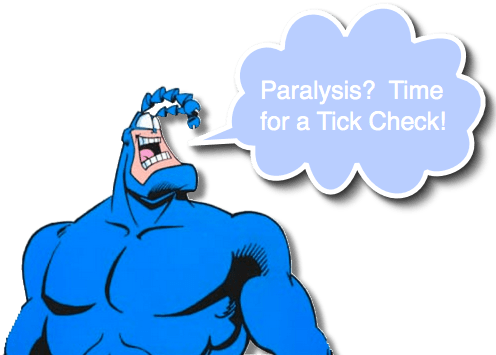Tick Paralysis
Ascending paralysis naturally evokes concern for Guillain-Barre syndrome, but one entity that should be on your differential and requires special action is Tick Paralysis. Let’s take a minute to refresh our memories about this interesting and important condition.
Presentation
- Prodrome con be seen and generally lasts < 24 hours.
- Restlessness and Irritability
- Fatigue
- Paresthesias
- Myalgias
- Fever is seldom present
- Acute symmetric ascending flaccid paralysis.
- Unsteady gait can be the initial finding.
- Usually develops 2-6 days after tick attachment (so consider where the patient may have been over the past several days).
- Decreased deep tendon reflexes.
- Progressive Ascending Weakness if the tick continues to feed.
- Can see weakness of upper extremities.
- Cranial nerve involvement can also be seen – drooling, dysphagia, dysphonia, and facial weakness.
- Opthalmoplegia and pupillary dilation have been reported.
- Atypical presentations have noted focal weakness or isolated facial weakness or isolated cerebellar ataxia.
- Involvement of the respiratory muscles can occur.
- Without supportive care, can lead to death.
- Historically, 6% of patients with tick paralysis died.
Risk Factors
- Girls with long hair
- < 8 years of age
- Spring and Summer months
- Regions:
- Australia (Ixodes holyclus)
- North America
- Rocky Mountain region, Pacific Northwest, Southwest Canada (Dermacentor andersoni)
- Southeast region (Dermacentor variabilis)
Pathophysiology
- The paralysis is caused by a neurotoxin that is produced in the tick’s salivary glands.
- The exact mechanism is not fully characterized.
- Believed to decrease the presynaptic acetylcholine release at the neuromuscular junction.
- May function similar to botulinum toxin.
Other Diagnoses Often Confused with Tick Paralysis
Naturally, evaluating a patient who presents with acute ascending weakness with hyporeflexia will generate concern for the following, and Tick Paralysis is important to consider as well. When you are considering any of these conditions, you should look closely for any attached ticks and ask about potential exposure. 22% of cases in the USA were initially misdiagnosed and the mean time for correct diagnosis was >2 days.
- Botulism
- Guillain-Barre Syndrome
- Myasthenia gravis
- Lambert-Eaton syndrome
- Diptheria
- Poliomyelitis
- Transverse myelitis
- Periodic paralysis
- Spinal Cord Compression
- Heavy metal poisoning
- Organophosphate poisoning
Diagnosis
- Tick paralysis is diagnosed based on clinical findings concurrent with discovering an engorged tick.
- There is not a specific test that is advocated to confirm the diagnosis.
- Laboratory studies and imaging is often done to rule out other entities.
- This is why considering Tick Paralysis and performing a Tick Check is important.
- There are known cases of MRIs being done for the evaluation of the weakness only to demonstrate an engorged tick (kinda creepy really– but also a waste of money to obtain an MRI of a Tick — ticks don’t have insurance).
- CSF studies are normal.
Treatment
- Simple – remove the tick
- With Dermacentor ticks, the symptoms tend to improve shortly after removal.
- With Ixodes ticks, the symptoms may persist for 1 – 2 days after removal.
- Some cases of prolonged symptoms have been noted in Australia.
Moral of the Morsel
Keep Tick Paralysis on your DDx when evaluating a patient with acute weakness and look closely for any attached ticks, as this may dramatically alter your potentially expensive and expansive evaluation.



[…] is their tendency to transmit awful diseases to us. These diseases (and unique conditions – Tick Paralysis) are numerous, but one of the most important to review (especially for those of us in North […]
[…] with infections in children, particularly in the Summer months. Tick Related infections (ex, RMSF, Tick Paralysis) are formidable foes and warrant our vigilance. Let us review another tick borne illness that is […]
[…] More: Tick Paralysis (Sean […]
[…] Tick paralysis. It’s not very common, but you are going to feel very silly if you miss that tick. Sean Fox on Pediatric EM Morsels takes a look. [TRD] […]